Moira Butterfield's Blog, page 24
October 14, 2019
The Little Island - Politics in Picture Books by Smriti Prasadam-Halls
I was recently surprised and pleased to be interviewed by the Sunday Times for a news piece about my latest picture book, The Little Island, illustrated by Robert Starling and published by Andersen Press. The book, which has been described as “Animal Farm for the Brexit generation”, tells the story of a group of animals on a farm who become disgruntled with their lot, living alongside the other animals, and decide to separate themselves from the rest of the farm.
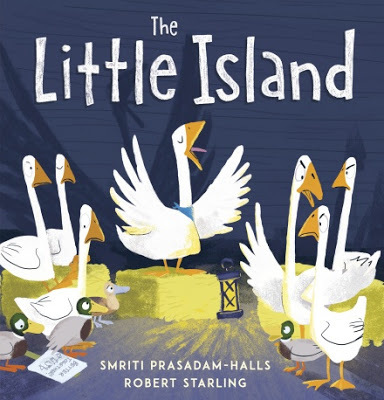
When the article came out, I was fascinated to see that the angle focused on what was seen to be a “new” trend in “political” picture books, leading with the headline, “Brexit waddles into children’s books”.
To my mind, however, picture books have always dealt with the political – politics with both with a large and a small P. Some have directly reflected the immediate concerns of the day and some have immersed themselves in exploring the politics of freedom, relationship and society. Some show us a snapshot of our times, perhaps from an angle we might not expect, while others have raised big issues allegorically; both approaches grappling with thought provoking issues sometimes satirically, but always with sympathy and tenderness.
Sometimes the subject is very much of the moment. I’ll never forget seeing the devastating animation of When the Wind Blows by Raymond Briggs as a teenager – huddled in a wind battered marquee at a music festival with a group of friends. Wide-eyed, we watched this picture book brought to life on the screen, perplexed by what felt, at that time, a genuine shadow of nuclear war. Commended and criticised for its ‘anti-war’ message, the rendering of the chilling tale was all the more powerful – and poignant – in the way that Briggs captured the naivete, vulnerability and intimacy of his utterly trusting, utterly decent characters, who firmly believe, “Ours is not to reason why.”

Often political themes are age old and there are few examples more effortlessly effective for me than David McKee’s The Conquerors. It’s a fable that explores imperialism and multiculturalism in an allegory which suggests that nonviolence has a far greater impact than aggressive militarism. Here, a general leads his army against less powerful countries. “It’s for their own good,” he declares. “So they can be like us.” Yet at the end of the story, when the only customs and songs known to the General belong to the little country he has ‘conquered’ we are left with a smile on our lips, wondering precisely who in the story has been conquered by whom? Disarming in every way.
In The Little Island I’ve borrowed from both these storytelling traditions. The book combines the big issues of our global political landscape – Brexit, fear of ‘the other’, a hankering for the ‘glorious’ past – along with timeless themes of compassion and cooperation that are relevant in every age. In this allegory, the parallels with today’s political situation are clear to an adult reader, but for a child this is a story about solidarity and togetherness, where where friendship and hope prevail.

My own hope is that picture books – whether viewed as political or otherwise – will remain fearless in taking on controversial topics, challenging preconceptions and creating a space where children and adults question, discuss and explore together the big issues of our time. Here’s hoping we’ve got some answers…
Smriti Prasadam-Halls the best selling picture book author of Don't Make Me Cross, The World of the Whale, The Days of the Wolf, You Make ME Happy! and T-Veg the Story of a Carrot Crunching Dinosaur, amongst many. Visit Smriti's website here.
The Little Island is illustrated by Robert Starling and published by Andersen Press
Visit Robert Starling's website here


When the article came out, I was fascinated to see that the angle focused on what was seen to be a “new” trend in “political” picture books, leading with the headline, “Brexit waddles into children’s books”.
To my mind, however, picture books have always dealt with the political – politics with both with a large and a small P. Some have directly reflected the immediate concerns of the day and some have immersed themselves in exploring the politics of freedom, relationship and society. Some show us a snapshot of our times, perhaps from an angle we might not expect, while others have raised big issues allegorically; both approaches grappling with thought provoking issues sometimes satirically, but always with sympathy and tenderness.
Sometimes the subject is very much of the moment. I’ll never forget seeing the devastating animation of When the Wind Blows by Raymond Briggs as a teenager – huddled in a wind battered marquee at a music festival with a group of friends. Wide-eyed, we watched this picture book brought to life on the screen, perplexed by what felt, at that time, a genuine shadow of nuclear war. Commended and criticised for its ‘anti-war’ message, the rendering of the chilling tale was all the more powerful – and poignant – in the way that Briggs captured the naivete, vulnerability and intimacy of his utterly trusting, utterly decent characters, who firmly believe, “Ours is not to reason why.”

Often political themes are age old and there are few examples more effortlessly effective for me than David McKee’s The Conquerors. It’s a fable that explores imperialism and multiculturalism in an allegory which suggests that nonviolence has a far greater impact than aggressive militarism. Here, a general leads his army against less powerful countries. “It’s for their own good,” he declares. “So they can be like us.” Yet at the end of the story, when the only customs and songs known to the General belong to the little country he has ‘conquered’ we are left with a smile on our lips, wondering precisely who in the story has been conquered by whom? Disarming in every way.
In The Little Island I’ve borrowed from both these storytelling traditions. The book combines the big issues of our global political landscape – Brexit, fear of ‘the other’, a hankering for the ‘glorious’ past – along with timeless themes of compassion and cooperation that are relevant in every age. In this allegory, the parallels with today’s political situation are clear to an adult reader, but for a child this is a story about solidarity and togetherness, where where friendship and hope prevail.

My own hope is that picture books – whether viewed as political or otherwise – will remain fearless in taking on controversial topics, challenging preconceptions and creating a space where children and adults question, discuss and explore together the big issues of our time. Here’s hoping we’ve got some answers…
Smriti Prasadam-Halls the best selling picture book author of Don't Make Me Cross, The World of the Whale, The Days of the Wolf, You Make ME Happy! and T-Veg the Story of a Carrot Crunching Dinosaur, amongst many. Visit Smriti's website here.
The Little Island is illustrated by Robert Starling and published by Andersen Press
Visit Robert Starling's website here

Published on October 14, 2019 02:39
October 6, 2019
That's a lot of blog posts on writing and illustrating children's picture books • Paeony Lewis
Wow, I've been blogging at the Picture Book Den since it began almost eight years ago. Sadly, now that I've started a Fine Art MA, it's time to take an extended break. So to say goodbye (oh, I feel all emotional!) I thought I'd list my main blog posts (see further down) and do click on those that appeal. They're on writing, illustration and the world of children's picture books.
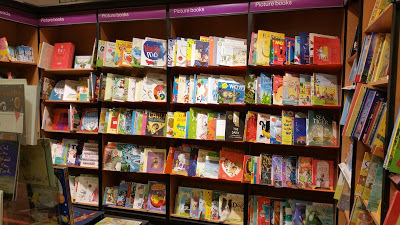
The statistics on the viewing figures for my different blog posts intrigued me. I discovered the blog post viewed the most was on the picture book differences between bookshop chains in the US and UK. This was written in 2016 and had several thousand more views than my least popular post (that's a secret!). I suspect the viewing figures increased because of the US reference (there's many more of you in the US than UK).
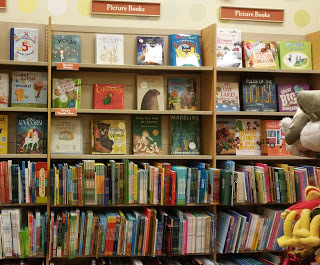
If you're new to writing picture books then perhaps begin with the 2018 Starting to write picture books and also What's at the heart of a picture book?, which although written in 2013 includes vital advice that is often forgotten.
As for my personal favourite, well of course I'm going to say it's impossible to pick one but... My blog post on the convoluted journey of one particular story still makes me smile and I hope it encourages others to persevere with their writing. I also really enjoyed looking at illustration, such as investigating dioramas and 3D illustration in picture books.

List of Blog Posts (newest first)
Dioramas and 3D illustration in children's picture booksIllustrating water in children's picture booksIllustrating the night in children's picture booksStarting to write children's picture booksSo much effort for something so small (the journey of one picture book text)Favourite picture books of writers and illustratorsLooking at illustraton: traditional printmaking in children's picture booksIntriguing details in picture book illustration Picture book differences between the main main bookshop chains in the US and UKPicture books that made me pause (for good, bad and surprising reasons)Looking at the illustration of eyes in children's picture books (with four illustrators)Little niggles in manuscriptsMore tips on writing picture booksLooking at the 'art' in picture book illustrationExtra tips on writing picture booksDo hardback children's picture books lack something?Throwing out old picture booksWhy do some picture books stay in print for decades?The right wordsGo on, try an experiment with your picture book writingWhy did the picture-book illustrators grumble about drawing horses?Bye for now, Paeony
PS I'm still writing, when not enmeshed in book arts and conceptual art.
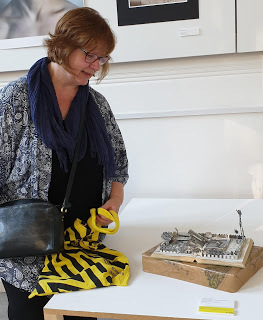 www.paeonylewis.com
www.paeonylewis.com
Published on October 06, 2019 23:30
September 29, 2019
Creative Process • by Natascha Biebow
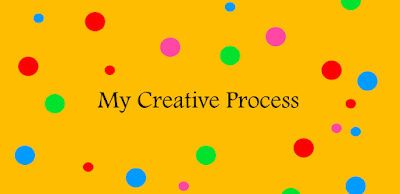
I recently had an epiphany about the creative process.
Here’s how it goes:
Imagine you walk into a house.
You look around, take in the atmosphere, the furnishings, the knick-knacks (or the lack there-of), the smell . . . you start to make a story in your head about the house and the people who live there.
So, there’s a story right there.
But what if you dig a little deeper? What if you look in the attic, under the floorboards, or in the historical records about the house and its owners?
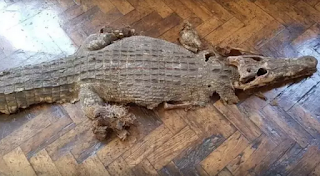 This crocodile - a gift from a WW1 veteran - was uncovered beneath
This crocodile - a gift from a WW1 veteran - was uncovered beneaththe floorboards of a Welsh Primary - what surprising items
will be beneath the 'floorboards' of the story you're crafting?
A new story slowly emerges . . .
Some of it is unfamiliar, strange, even.
So, now you’ve got to sit with the unfamiliar, the blank page. What next? Is THIS the story you ask? Sit with it for a moment.

But sitting with that blank page is scary. What if the story doesn’t come? What if it isn’t good enough? What if nobody likes it?
The fear grows. EMPTINESS. The story stops.
But hang on a minute.
Get out of your way! Look FEAR in the eye. TRUST the process.
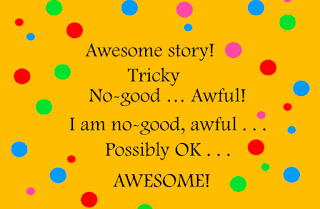
Fear is your friend. Look harder at the story, for the story.
Ask it what’s at its heart. What is the feeling of the story?
What is it telling you, telling the world?
What would a child really like about this story?
Now, I give myself permission to be inspired by other things. I leaf through magazines. I go to galleries, parks, playgrounds, writing events or whatever lends itself to the theme at hand. Completely unconnected things are often the best way to kick-start the writing process in new, exciting directions.
Recently, I heard author M. T. Anderson said speak:
"Don't just live in the place you live." Authors need to embrace the unfamiliar, he said. "Open up the floors and see what's there. Explore the strange and the new, and make it your own . . . that is where the sublime happens."
How can you make it your own?
Only you can look for the story inside, in the pockets of life that you carry around with you.
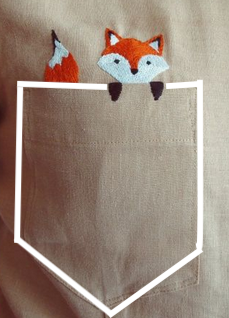
But if you’re brave enough . . . What might you uncover? Something unexpected, something exciting – just waiting to be discovered!

And so your story, those words on the page, they start to take shape, to have more depth, and maybe now they also have more resonance too.
Because they are bigger, wider. They reach into the world into place other people, your readers, can also connect with. When they visit, maybe they’ll see other things, perhaps even things you never even saw in the original story.
And so . . . they will find in it their spirit, their connection, too.

And this is a process of creating story. It isn’t ever the same, but perhaps we can all share something in this experience?
_______________________________________________________________
Natascha Biebow, MBE, Author, Editor and Mentor
 Natascha is the author of The Crayon Man: The True Story of the Invention of Crayola Crayons, illustrated by Steven Salerno, Elephants Never Forget and Is This My Nose?, editor of numerous award-winning children’s books, and Co-Regional Advisor (Co-Chair) of SCBWI British Isles. She is currently working on more non-fiction and a series of young fiction. She runs Blue Elephant Storyshaping, an editing, coaching and mentoring service aimed at empowering writers and illustrators to fine-tune their work pre-submission. Find her at www.nataschabiebow.com
Natascha is the author of The Crayon Man: The True Story of the Invention of Crayola Crayons, illustrated by Steven Salerno, Elephants Never Forget and Is This My Nose?, editor of numerous award-winning children’s books, and Co-Regional Advisor (Co-Chair) of SCBWI British Isles. She is currently working on more non-fiction and a series of young fiction. She runs Blue Elephant Storyshaping, an editing, coaching and mentoring service aimed at empowering writers and illustrators to fine-tune their work pre-submission. Find her at www.nataschabiebow.com <!-- /* Font Definitions */ @font-face {font-family:"MS 明朝"; panose-1:0 0 0 0 0 0 0 0 0 0; mso-font-charset:128; mso-generic-font-family:roman; mso-font-format:other; mso-font-pitch:fixed; mso-font-signature:1 134676480 16 0 131072 0;} @font-face {font-family:"MS 明朝"; panose-1:0 0 0 0 0 0 0 0 0 0; mso-font-charset:128; mso-generic-font-family:roman; mso-font-format:other; mso-font-pitch:fixed; mso-font-signature:1 134676480 16 0 131072 0;} @font-face {font-family:"Trebuchet MS"; panose-1:2 11 6 3 2 2 2 2 2 4; mso-font-charset:0; mso-generic-font-family:auto; mso-font-pitch:variable; mso-font-signature:647 0 0 0 159 0;} /* Style Definitions */ p.MsoNormal, li.MsoNormal, div.MsoNormal {mso-style-unhide:no; mso-style-qformat:yes; mso-style-parent:""; margin:0cm; margin-bottom:.0001pt; mso-pagination:widow-orphan; font-size:12.0pt; font-family:"Times New Roman"; mso-fareast-font-family:"MS 明朝"; mso-fareast-theme-font:minor-fareast; mso-ansi-language:EN-US;} .MsoChpDefault {mso-style-type:export-only; mso-default-props:yes; font-size:10.0pt; mso-ansi-font-size:10.0pt; mso-bidi-font-size:10.0pt; mso-fareast-font-family:"MS 明朝"; mso-fareast-theme-font:minor-fareast; mso-fareast-language:JA;} @page WordSection1 {size:595.0pt 842.0pt; margin:72.0pt 90.0pt 72.0pt 90.0pt; mso-header-margin:35.4pt; mso-footer-margin:35.4pt; mso-paper-source:0;} div.WordSection1 {page:WordSection1;} -->
Published on September 29, 2019 19:00
September 22, 2019
Snerting Your Picture Book Text, by Pippa Goodhart
‘Snerting’ is a family word that has proved useful when thinking about writing. ‘Snerting’ is a sort of cross between ‘sneering’ and ‘editing’, appreciating nice things but also pointing out errors and possibly making suggestions for changes. My husband is often the first ‘snerter’ of my stories after I’ve done all I can. My daughters have been paid snerters for me in the past. And I’m lucky enough to have a patient and inspired agent who is a very expert, professional and kind snerter. But a writer must always critique their own work too, so I’ve put together some key points to consider when you are snerting your own picture book texts before sending them off to agents or editors.
- Does my story or book game address the right age and interests for the picture book audience? Do the emotional issues in it resonate with the limited life experiences of young children? Is that emotional core of the story about something young children care about with a passion?
- Is my story balanced, starting by ‘asking’ and finishing by ‘answering’ the central story question? Does the middle part of my story rise to a crisis, perhaps just over half way through, before resolving?
- Do my characters come alive in my story? Would a reader feel that these characters have a fictional life beyond what is seen here? It’s only if characters are ‘believable’ and relatable (even if they are an animated potato) that we’ll care enough to mind what happens to them.
- If my picture book isn’t telling a story, but is instead presenting a game to share with the book audience, does that game actively involve the child audience enough?
- Does my text read aloud easily and pleasingly? That may involve rhythm, perhaps even some rhyme, but, first and foremost, it must mean that the story is clearly conveyed in sentences that don’t trip the reader up. Always read out loud to test it. Better still, get somebody else to read it out loud to you.
- Is there something worthy of a new illustration after every page turn? Am I using page turns to best dramatic effect?
- Does every word in my text earn the space it is taking away from potential illustration? If I cut a line, a paragraph, a word, will it improve the read without losing anything vital from the story? If so, do it.
- Is there a clear marketing opportunity for my story, and, if so, does the story work in the best way it can to suit that opportunity?
- Have I laid out my story in such a way that an editor can choose to easily read just the story text, or can read story text along with any necessary picture notes?
- Do I love my story? If not, it’s unlikely others will!
Happy snerting!

Published on September 22, 2019 16:30
September 15, 2019
Getting Side Tracked • Lynne Garner
A week or so ago I came across a video taken by a guy who regularly sets up a trail camera in woods near to where he lives. As I watched I knew I wanted to use it as a basis for a new picture book story. As I watched I took notes but knew I also needed to do a little research.
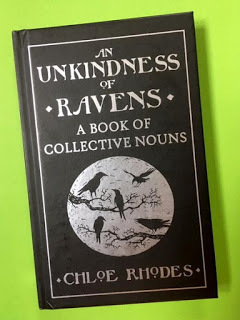 A gift a few years ago - fab little bookAs my new story will feature animals I know little about, they were my starting point. Although my animals will talk, I believe their lives should bear some resemblance to the real ones. Unfortunately, the issue is when I research I get side tracked. As per usual I found a couple of facts I needed plus a few I didn’t. For example, did you know a baby racoon is called a kit or a cub? Also, female racoon with her young is called a nursery – I do like collective nouns.
A gift a few years ago - fab little bookAs my new story will feature animals I know little about, they were my starting point. Although my animals will talk, I believe their lives should bear some resemblance to the real ones. Unfortunately, the issue is when I research I get side tracked. As per usual I found a couple of facts I needed plus a few I didn’t. For example, did you know a baby racoon is called a kit or a cub? Also, female racoon with her young is called a nursery – I do like collective nouns.
Of course, this side tracked me and I had to find out if nursery was used as a collective noun for other animals. After a while I discovered a nursery is also used for a group of Coati. Happy with this I forced myself back on track and continued to research the topic in hand.
 Fact: a hedge is just bushes, whilst a
Fact: a hedge is just bushes, whilst a
hedgerow is a mix of bushes and trees.Once I’d researched the animals, I needed to research the types of trees my characters would encounter. This was when I stumbled on something very dear to my heart, supporting our environment. Somehow and I have no idea how I moved from trees of the US to the UK. This is when I discovered there are two places you can obtain free trees and hedging kits. Coincidentally I'm 'into' hedges and hedgerows at the moment due the book I’m reading A Natural History of the Hedgerow.
The first organisation giving away free tree and hedging packs is The Woodlands Trust (click here for more information). Schools and community groups can apply for their free packs. So, if you’re connected to either why not let them know about this great initiative and encourage them to apply.
Also, the government have £10 million put aside to fund the planting of 130,000 trees as part of their Urban Tree Challenge Fund. They are now accepting applications of interest from individuals (like minded neighbours who want to improve their street or local park), local authorities, charities and NGOs for trees to be planted 2020/2021. The scheme is being administered by the Forestry Commission (click here for more information).
Even after allowing myself to be side tracked I managed to find the information I needed. And I’m pleased to say my latest picture book story is in its third draft. Just a little more tweaking and my next task will be to research a suitable publisher. With fingers crossed I’ll get less side tracked, but I doubt it.
Blatant plug time
Love a short story?
 Then check out my short story collections - available in paperback and ebooks versions (most ebooks are available at the low price of 99p/99¢ each):
Then check out my short story collections - available in paperback and ebooks versions (most ebooks are available at the low price of 99p/99¢ each):
Hedgehog of Moon Meadow Farm (10 stories)
Fox of Moon Meadow Farm (10 stories)
Ten Tales of Brer Rabbit (10 stories)
Ten Tales of Coyote (10 stories)
Anansi The Trickster Spider (ebook £1.49/$1.49 - 16 stories)
 A gift a few years ago - fab little bookAs my new story will feature animals I know little about, they were my starting point. Although my animals will talk, I believe their lives should bear some resemblance to the real ones. Unfortunately, the issue is when I research I get side tracked. As per usual I found a couple of facts I needed plus a few I didn’t. For example, did you know a baby racoon is called a kit or a cub? Also, female racoon with her young is called a nursery – I do like collective nouns.
A gift a few years ago - fab little bookAs my new story will feature animals I know little about, they were my starting point. Although my animals will talk, I believe their lives should bear some resemblance to the real ones. Unfortunately, the issue is when I research I get side tracked. As per usual I found a couple of facts I needed plus a few I didn’t. For example, did you know a baby racoon is called a kit or a cub? Also, female racoon with her young is called a nursery – I do like collective nouns.Of course, this side tracked me and I had to find out if nursery was used as a collective noun for other animals. After a while I discovered a nursery is also used for a group of Coati. Happy with this I forced myself back on track and continued to research the topic in hand.
 Fact: a hedge is just bushes, whilst a
Fact: a hedge is just bushes, whilst a hedgerow is a mix of bushes and trees.Once I’d researched the animals, I needed to research the types of trees my characters would encounter. This was when I stumbled on something very dear to my heart, supporting our environment. Somehow and I have no idea how I moved from trees of the US to the UK. This is when I discovered there are two places you can obtain free trees and hedging kits. Coincidentally I'm 'into' hedges and hedgerows at the moment due the book I’m reading A Natural History of the Hedgerow.
The first organisation giving away free tree and hedging packs is The Woodlands Trust (click here for more information). Schools and community groups can apply for their free packs. So, if you’re connected to either why not let them know about this great initiative and encourage them to apply.
Also, the government have £10 million put aside to fund the planting of 130,000 trees as part of their Urban Tree Challenge Fund. They are now accepting applications of interest from individuals (like minded neighbours who want to improve their street or local park), local authorities, charities and NGOs for trees to be planted 2020/2021. The scheme is being administered by the Forestry Commission (click here for more information).
Even after allowing myself to be side tracked I managed to find the information I needed. And I’m pleased to say my latest picture book story is in its third draft. Just a little more tweaking and my next task will be to research a suitable publisher. With fingers crossed I’ll get less side tracked, but I doubt it.
Blatant plug time
Love a short story?
 Then check out my short story collections - available in paperback and ebooks versions (most ebooks are available at the low price of 99p/99¢ each):
Then check out my short story collections - available in paperback and ebooks versions (most ebooks are available at the low price of 99p/99¢ each):Hedgehog of Moon Meadow Farm (10 stories)
Fox of Moon Meadow Farm (10 stories)
Ten Tales of Brer Rabbit (10 stories)
Ten Tales of Coyote (10 stories)
Anansi The Trickster Spider (ebook £1.49/$1.49 - 16 stories)
Published on September 15, 2019 22:00
September 9, 2019
Making It Personal: Harvesting Picture Books From Real Experiences by Clare Helen Welsh
We all know that finding an original picture book idea is tough. Extremely tough. But one way of being unique, is to make your writing personal. There is only one you, after all!
Twenty authors could all write stories about bears, but what would make yours different from everyone else’s is what you bring; your experience, your style, what you notice, know and believe to be important about bears. No-one can replicate you and that’s what will help your text stand out to publishers.
So how do we cultivate our ‘You-ness’ ? - a term I first heard author, Catherine Johnson, use at the SCBWIBI Conference in Winchester - and how do we turn it into picture book gold?
Try writing down all the experiences, people, memories, interactions that are important to you. Choose one and consider: - Is it interesting to others?- Is it helpful to others? - Is it (or can it be) told from a child’s perspective?
This last point is particularly important. You will need to craft your emotion into something accessible for the age group you are writing for. Remember that just because something resonates with us as adults, doesn’t necessarily mean it will touch or entertain a child in the same way. Emotion is hugely important in picture books, but your text still needs excitement and tension to make children want to come back to it again and again.
It’s perhaps helpful to expand your mindset when working in this way. Your final text might not actually be the whole of the thing you experienced. Once you have taken the nub of the idea/memory/emotion and sculpted it into something children will enjoy, it might only be a snippet of your original experience; a phrase, a character or an idea that you can use as a springboard for something else.
As an example, my most recent picture book, The Tide (illustrated by Ashling Lindsey and published by Little Tiger), started life as a phrase that my children kept repeating whilst on a day trip to the beach; ‘The tide is coming in! The tide is coming in!’ I wrote whilst they played. It was very special to sit back and watch them. It was also the first time they learned about tides.
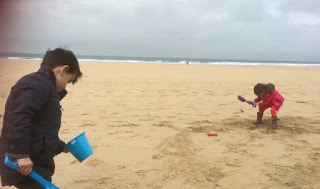
On the beach at Perran Sands, Cornwall (April 2015)
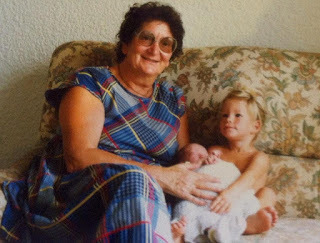
Ronnie Spry, who lived with dementia, with two of her grandchildren.
Six months later, this memory had very much stayed with me, and so I used it as inspiration for a book about dementia, told from a child’s point of view. There were already some very good books for children on the subject. I know because my children’s Grandma lived with dementia towards the end of her life. Their Grandma wasn’t with us on our beach trip. No-one even mentioned or talked about dementia on that day. In fact, the final text doesn’t bear much resemblance to our trip at all. But the emotion is there. And a few little details that make the text feel fully-rounded; my children did play in the rock pools. They did build forts and castles and they did laugh in and shower in the salty spray. Their song, ‘The tide is coming in! The tide is coming in!’ also features, as a refrain in the book. Using the tide as a metaphor for memories that come and go, was unique and original to me. It was my way in to a subject written about many times before.
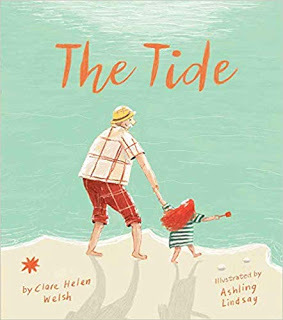
(c) Ashling Lindsay (2019)
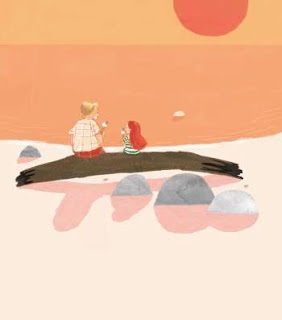
(c) Ashling Lindsay (2019)
Perhaps you also like working this way? It would be great to find out if you do.If not, perhaps give it a try …and let us know if you find picture book gold!
Clare is a children's writer and primary school teacher from Devon. She writes fiction and non-fiction picture book texts - sometimes funny and sometimes lyrical. Her first book was published in 2015, and she currently has books in development with Little Tiger Press, Quarto, Andersen, Nosy Crow and MacMillan. You can find out more about her at her website www.clarehelenwelsh.com or on Twitter @ClareHelenWelsh .
Published on September 09, 2019 00:00
September 1, 2019
Digging through it by Jane Clarke
On Saturday, I helped excavate a small test pit with my local archaeology group. It occurred to me that editing the first draft of a picture book text is a bit like being on a dig. At the start, it's hard to see what's there. You begin to strip away at it.
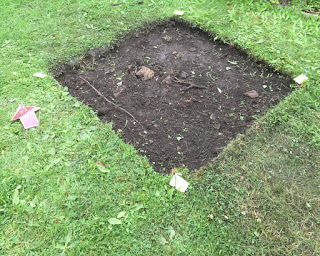
2. Layers are essential, but some layers just need removing, like this corrugated iron sheet.
 If something’s blocking the flow of your text, cut it out - even if it is easier to leave it in there and walk away!
If something’s blocking the flow of your text, cut it out - even if it is easier to leave it in there and walk away!
3.You don’t want to miss anything, so sieve through it carefully.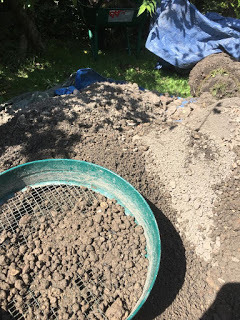
4. You are likely to discover many broken things.
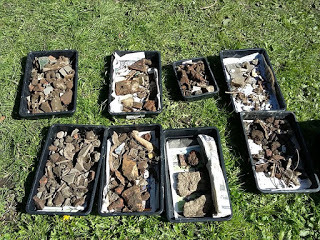 Can anything be pieced together? Discard a lot. Keep some. Either way, preserve a record. You might want to look at things again sometime.5. Remember it all started with the bedrock. Which in the case of our dig was waterlogged clay, but in a picture book is the theme of your text. Don’t lose sight of it.
Can anything be pieced together? Discard a lot. Keep some. Either way, preserve a record. You might want to look at things again sometime.5. Remember it all started with the bedrock. Which in the case of our dig was waterlogged clay, but in a picture book is the theme of your text. Don’t lose sight of it.
6. It's hard work, but it's fun, especially if your join in with others who share the madness.
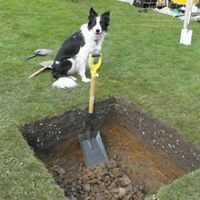 If you're looking for like-minded and helpful people, check out the Society of Children's Book Writers and Illustrators
If you're looking for like-minded and helpful people, check out the Society of Children's Book Writers and Illustrators
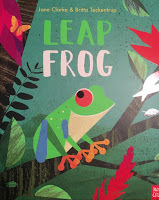 Jane was once an archaeologist, but is now a full time writer. Her latest picture book is Leap Frog, illustrated by Britta Teckentrup. For those who are interested, the test pit revealed a lot of rubbish - but also 3 shards of fifteenth century earthenware, 2 of late Anglo- Saxon pottery and a worked flint (probably Mesolithic). There was no sign of any structure. The dig was carefully recorded on a University of Leicester data base.
Jane was once an archaeologist, but is now a full time writer. Her latest picture book is Leap Frog, illustrated by Britta Teckentrup. For those who are interested, the test pit revealed a lot of rubbish - but also 3 shards of fifteenth century earthenware, 2 of late Anglo- Saxon pottery and a worked flint (probably Mesolithic). There was no sign of any structure. The dig was carefully recorded on a University of Leicester data base.

2. Layers are essential, but some layers just need removing, like this corrugated iron sheet.
 If something’s blocking the flow of your text, cut it out - even if it is easier to leave it in there and walk away!
If something’s blocking the flow of your text, cut it out - even if it is easier to leave it in there and walk away!3.You don’t want to miss anything, so sieve through it carefully.

4. You are likely to discover many broken things.
 Can anything be pieced together? Discard a lot. Keep some. Either way, preserve a record. You might want to look at things again sometime.5. Remember it all started with the bedrock. Which in the case of our dig was waterlogged clay, but in a picture book is the theme of your text. Don’t lose sight of it.
Can anything be pieced together? Discard a lot. Keep some. Either way, preserve a record. You might want to look at things again sometime.5. Remember it all started with the bedrock. Which in the case of our dig was waterlogged clay, but in a picture book is the theme of your text. Don’t lose sight of it.6. It's hard work, but it's fun, especially if your join in with others who share the madness.
 If you're looking for like-minded and helpful people, check out the Society of Children's Book Writers and Illustrators
If you're looking for like-minded and helpful people, check out the Society of Children's Book Writers and Illustrators Jane was once an archaeologist, but is now a full time writer. Her latest picture book is Leap Frog, illustrated by Britta Teckentrup. For those who are interested, the test pit revealed a lot of rubbish - but also 3 shards of fifteenth century earthenware, 2 of late Anglo- Saxon pottery and a worked flint (probably Mesolithic). There was no sign of any structure. The dig was carefully recorded on a University of Leicester data base.
Jane was once an archaeologist, but is now a full time writer. Her latest picture book is Leap Frog, illustrated by Britta Teckentrup. For those who are interested, the test pit revealed a lot of rubbish - but also 3 shards of fifteenth century earthenware, 2 of late Anglo- Saxon pottery and a worked flint (probably Mesolithic). There was no sign of any structure. The dig was carefully recorded on a University of Leicester data base.
Published on September 01, 2019 22:30
August 25, 2019
Lost in Picture Book Maps with Mini Grey
Lost in Picture Book Maps

My First Maps
My first map-love as a child was my grandfather’s Reader’s Digest Atlas of the World.
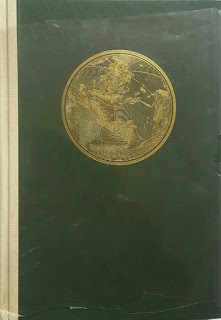 Now I own it, but I used to just visit it at my Grandpa's house. It was really big, big enough for a small child to be lost in, and my grandpa Noel Grey had inscribed his initials NWG on all the places he had visited, prospecting for oil I suspect. Here he is at large around South America.
Now I own it, but I used to just visit it at my Grandpa's house. It was really big, big enough for a small child to be lost in, and my grandpa Noel Grey had inscribed his initials NWG on all the places he had visited, prospecting for oil I suspect. Here he is at large around South America.  Here's a photo he took of Ernest Hemingway with an enormous marlin - apparently they went fishing together.
Here's a photo he took of Ernest Hemingway with an enormous marlin - apparently they went fishing together. 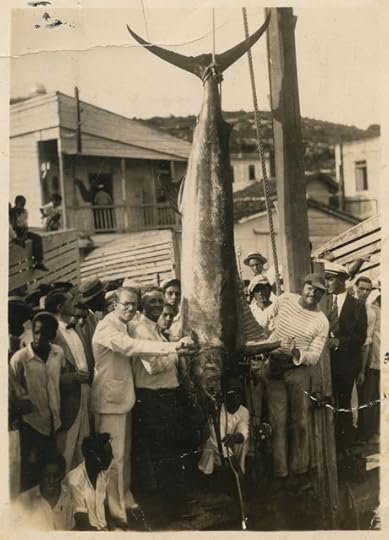
On one map he has urgently written GOLD, somewhere along the Amazon, in Peru.
 There's a bit of a diagram too.
There's a bit of a diagram too. 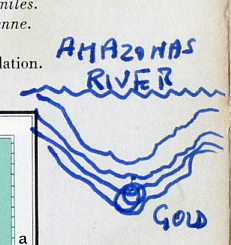 I started writing this post before the fires in the Amazon had beome the terrifying news they are now. From this perspective my Grandfather's charting of 'GOLD' is a bit bitterly ironic; anyone with any sense now knows that the most precious treasure to be found in the Amazon is the rainforest itself. Maps of Discovery, Power and Plunder
I started writing this post before the fires in the Amazon had beome the terrifying news they are now. From this perspective my Grandfather's charting of 'GOLD' is a bit bitterly ironic; anyone with any sense now knows that the most precious treasure to be found in the Amazon is the rainforest itself. Maps of Discovery, Power and Plunder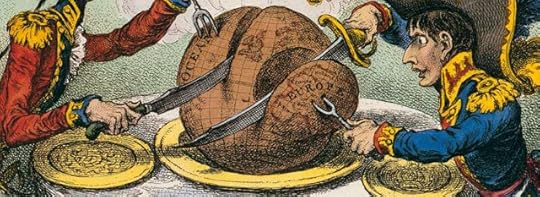
A map is a place to roam about in the imagination. A map is a record of the discovered and the undiscovered – terra incognita. A map is a plan for plundering, or a diagram of how to carve the world up, a record of ownership.
Here is the Carta marina, a wallmap of Scandinavia, by Olaus Magnus. It is the first map of the Nordic countries to give details and place names, initially published in 1539.

It seems to be awash with splendid mythical beasts. Did the map-maker think they were real, or was drawing the map of the far-away giving them permission to invent the most bizarre creatures they could concoct? Creatures include a literal sea-cow and sea-unicorn, whales with flowing tresses, a sea-elephant or Rosmarus and a Polypus which looks like a giant lobster. But it looks like Magnus was trying to depict what was really there – the land animals are fairly realistic, and many of the sea-creatures could be reinventions of existing ones: the sea unicorn: a narwhal, the Rosmarus: a walrus, the Polypus perhaps an octopus. Because they’re water beasts they are hard to get the measure of without diving equipment. Here are a selection of map-beasts:
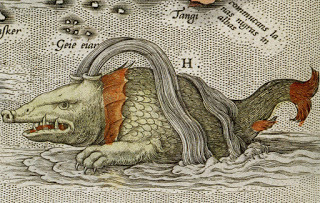 Probably a whale but it's quite boar-like
Probably a whale but it's quite boar-like
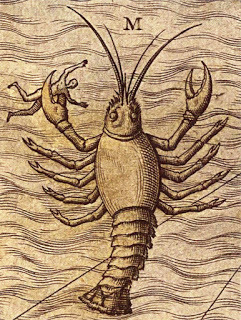 a Polypus
a Polypus
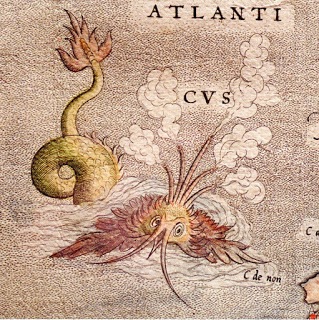 This has everything
This has everything
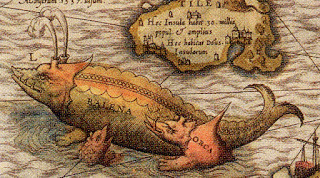 a Belena - whale - with an orca
a Belena - whale - with an orca 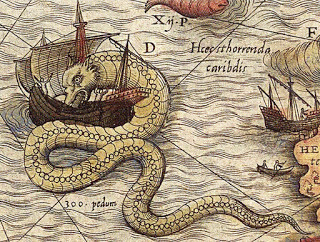 a sea serpentYou can explore the monsters here:
a sea serpentYou can explore the monsters here: Mulling with a Map

'I wisely started with a map and made the story fit,' JRR Tolkien once wrote.
In older children’s books, a map may well be the only illustration. The map is often a charting of the story journey.
When inventing the Hobbit story JRR Tolkein started with drawing Thror’s map.
 Drawing the map was part of the process of creating the story.
Drawing the map was part of the process of creating the story.Here's the map from Winnie the Pooh, drawn by Christopher Robin, with a bit of help from Ernest Shepard,
 and the map from the beginning of the Narnia book of the Horse and his Boy, mostly desert (by Pauline Baynes.)
and the map from the beginning of the Narnia book of the Horse and his Boy, mostly desert (by Pauline Baynes.) 
As it was sometimes the only picture in the book I would return to the map again and again, and trace my protagonist’s journey and mull over the places on the way.
And maps lend a touch of reality – a promise that the story may take you to real places.
When Gulliver’s Travels by Jonathan Swift was published in 1726 it was a roaring success but some did not realise it was fantasy.
“It is full of improbable lies, and, for my part, I hardly believe a word of it” exclaimed an eminent bishop. The Duchess of Marlborough was said to be ‘in raptures at it; she says she can dream of nothing else since she read it.’ A tale circulated about one old gentleman who, after reading the book, was alleged to have gone immediately to his atlas to search for Lilliput.
Here’s my map for Money Go Round by Roger McGough – as this book is deep in Wind in the Willows territory I had to start with communing with EH Shepard’s Willows map.

Picture Book Story Maps
 Moving to more picture book territory, a map can be a journey or a map of characters or events.
Moving to more picture book territory, a map can be a journey or a map of characters or events. 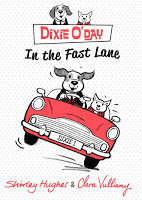 Here’s Dixie O’Day’s Map from Dixie O'Day in the Fast Lane by Shirley Hughes and Clara Vulliamy.
Here’s Dixie O’Day’s Map from Dixie O'Day in the Fast Lane by Shirley Hughes and Clara Vulliamy.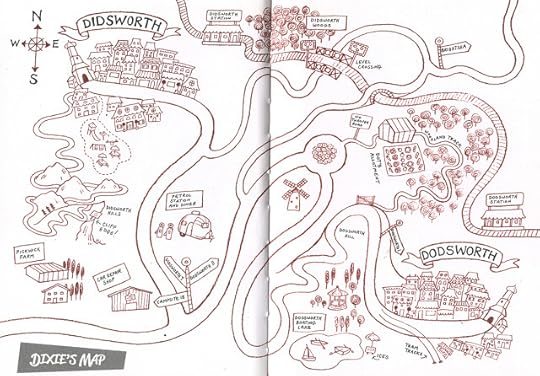 It is used by Dixie in the story and we can find where every event happens in an extremely satisfying way.
It is used by Dixie in the story and we can find where every event happens in an extremely satisfying way.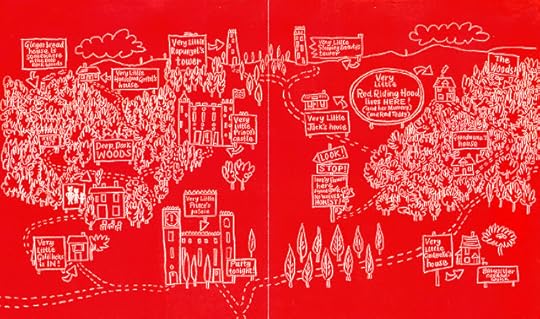
From a map of events to a map of characters: here is the map from Very Little Red Riding Hood by Teresa Heapy and Sue Heap – the places are the people.
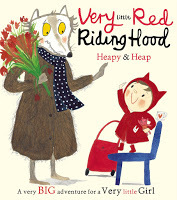 I can’t resist putting in these fresh and lovely animated spreads of the poor wolf getting more than it can deal with from Very Little Red.
I can’t resist putting in these fresh and lovely animated spreads of the poor wolf getting more than it can deal with from Very Little Red. 

In The Cat Who Got Carried Away by Allan Ahlberg and Katharine McEwen there are three very important maps.
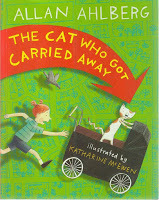 Here's the first one.
Here's the first one. And, oh, how delicious - we can see the cars and the characters and the shady old geezer with the suspicious pram and Horace the cat. This is a useful map of a particular moment, which shows exactly where the pram is, and white van skulduggery, and the impending fate of Horace the cat.
And, oh, how delicious - we can see the cars and the characters and the shady old geezer with the suspicious pram and Horace the cat. This is a useful map of a particular moment, which shows exactly where the pram is, and white van skulduggery, and the impending fate of Horace the cat.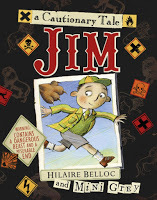 When I was making the book of Jim, the cautionary tale by Hilaire Belloc, I wanted to put in a map of the zoo where Jim meets his lion.
When I was making the book of Jim, the cautionary tale by Hilaire Belloc, I wanted to put in a map of the zoo where Jim meets his lion. 
 Jim has a yearning to run away, and when I was making the book there seemed to be more and more health and safety rules appearing everywhere and children seemed to be getting less and less freedom. So the Zoo Map is a map of the Safest Zoo in the World, one where everything is either shut or off-limits or prohibited.
Jim has a yearning to run away, and when I was making the book there seemed to be more and more health and safety rules appearing everywhere and children seemed to be getting less and less freedom. So the Zoo Map is a map of the Safest Zoo in the World, one where everything is either shut or off-limits or prohibited.  To make sure everything is completely safe, there are Zoo Rules on the back of the map.
To make sure everything is completely safe, there are Zoo Rules on the back of the map. 
Metaphorical Maps, Maps of the Soul
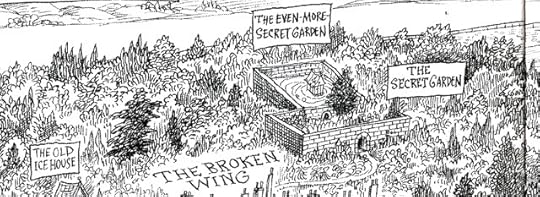
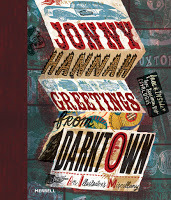 Here is Jonny Hannah’s Dark Town map from Greetings from Dark Town – complete with leviathans, Island of Profound Quotes, Sea of Impossibilities and beasts and more beasts.
Here is Jonny Hannah’s Dark Town map from Greetings from Dark Town – complete with leviathans, Island of Profound Quotes, Sea of Impossibilities and beasts and more beasts.

The first metaphorical map may have been for Pilgrim’s Progress, which also may have been one of the first novels (fictional prose narrative) in English. (Interestingly, other early novels include Robinson Crusoe and Gulliver’s Travels, both map-centred-adventure territory.) In Pilgrim we encounter unforgettable fictional places: the Slough of Despond, Vanity Fair, the House Beautiful, The Valley of the Shadow of Death.

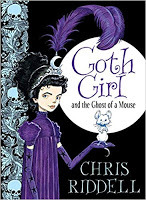 Here’s the Map of Ghastly Gorm Hall from Goth Girl, by Chris Riddell.
Here’s the Map of Ghastly Gorm Hall from Goth Girl, by Chris Riddell.  Note the Hall has an East Wing and a West Wing, but also a Broken Wing. As well as a Kitchen Garden, the Hall is complete with Bedroom Garden and Living Room Garden.
Note the Hall has an East Wing and a West Wing, but also a Broken Wing. As well as a Kitchen Garden, the Hall is complete with Bedroom Garden and Living Room Garden.  I’m planning my garden improvement already.
I’m planning my garden improvement already. One can meander round Metaphorical Smith’s Hobby-Horse Racecourse – with its Hill of Ambition, Gravel Path of Conceit, and Pond of Introspection.
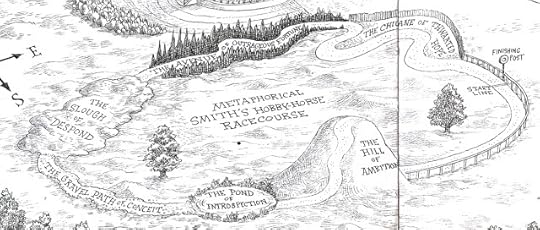
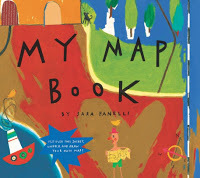 In Sara Fanelli’s My Map Book –we find a Map of my Heart, a Map of my Day.
In Sara Fanelli’s My Map Book –we find a Map of my Heart, a Map of my Day.

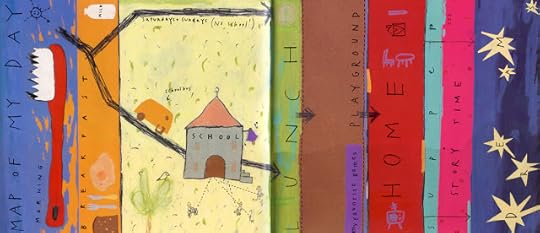
We’re wandering into maps that are states of mind, a map of how you feel, a map of time.
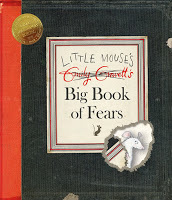 One of my absolutely favourite picture books is Emily Gravett’s Little Mouse’s Big Book of Fears. Mouse battles his terrors with the power of drawing. The book is extremely nibbled and so is Mouse’s pencil.
One of my absolutely favourite picture books is Emily Gravett’s Little Mouse’s Big Book of Fears. Mouse battles his terrors with the power of drawing. The book is extremely nibbled and so is Mouse’s pencil. 
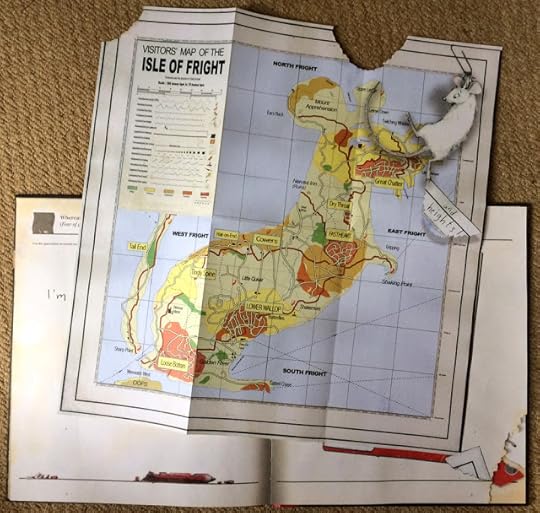 Here is the Map of the Isle of Fright, where the visitor can travel from Twitching Whiskers to Loose Bottom.
Here is the Map of the Isle of Fright, where the visitor can travel from Twitching Whiskers to Loose Bottom. 
And now - Exclusive to Picture Book Den:
Cut Out & Keep: Make Your Own Metaphorical Landscape Generator.
Simply cut out, combine randomly from column A and B and use the places created to make your own Metaphorical Landscape.

Impossible Maps

Making a map gives you freedom to map the impossible, to lose yourself in your scale of choice.
In A Boy & Bear in a Boat by Dave Shelton – here’s a map of nowhere. It’s almost not a map at all.

Here’s the map on the cover of the book (from the original hardback version)
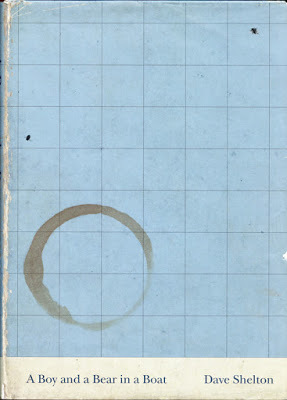 No features at all. Except a mug ring. But then, look again….squinting closely– there are two black splots.
No features at all. Except a mug ring. But then, look again….squinting closely– there are two black splots.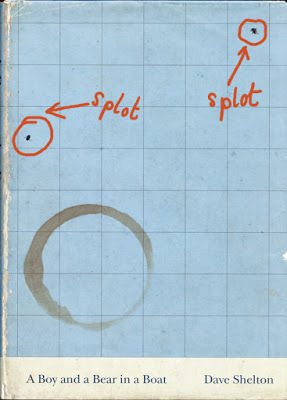 Focus in on one and it’s – yup, just a squashed fly.
Focus in on one and it’s – yup, just a squashed fly.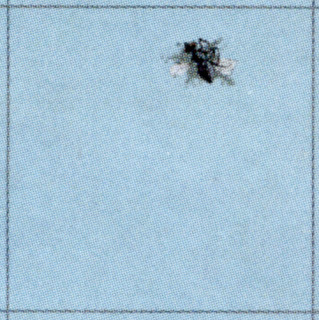 Then let’s pull right in on the other splot – I definitely see oars there.
Then let’s pull right in on the other splot – I definitely see oars there. 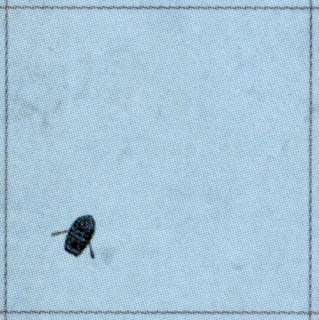
The scale of the bleak emptiness is immense, and I feel like I am falling through infinity.
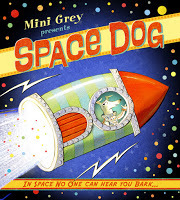 My book Space Dog started with thinking about making a space map. My son Herbie had a brilliant rocket toy. It came from the Early Learning Centre.
My book Space Dog started with thinking about making a space map. My son Herbie had a brilliant rocket toy. It came from the Early Learning Centre. 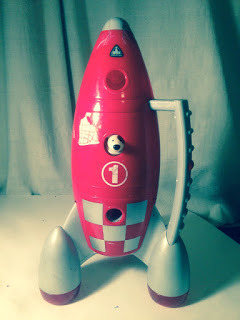
It was shaped a bit like a kettle with a handle, and you could fly it all round your home, exploring the Cistern System, the Pastaroid Belt and the Outer Spooniverse.
I wondered – what would space look like if the whole of the universe was actually everything in your house, in disguise. So here we have some Space Map Planetoids:
 FryUp42 with its ketchup volcanoes, the steamy planet of Bathtime 37 and Cornflake 5 and Bottleopolis which are in the Breakfast Cluster.
FryUp42 with its ketchup volcanoes, the steamy planet of Bathtime 37 and Cornflake 5 and Bottleopolis which are in the Breakfast Cluster.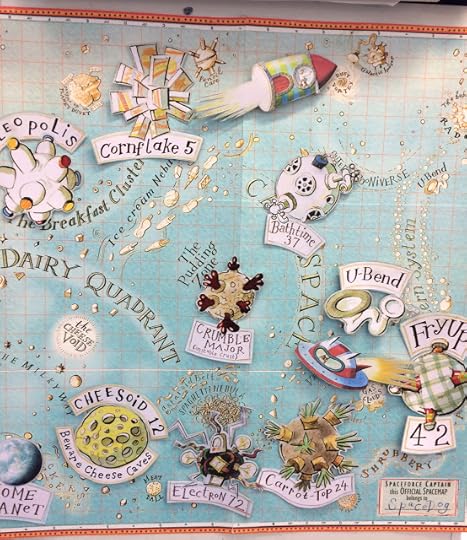
The Space Map was Space Dog’s endpapers, but, alas, they only appeared in the hardback version.

Download your own space map bits here, and make your own Space Map.
Maps and the Imagination

Take some words, maybe these ones which are a list of some things you might forget:
 Take a diagram of some islands, maybe these ones:
Take a diagram of some islands, maybe these ones: 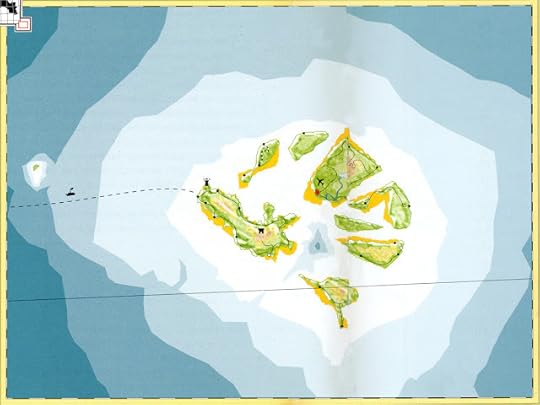 Put them both together, and what have you got?
Put them both together, and what have you got?The Isles of Forgetfulness.

This page comes from The Atlas of Experience by Louise van Swaaij and Jean Klare, which charts the human journey through life, with maps drawn in Subjective Projection and reproduced in Unimaginable Scale.
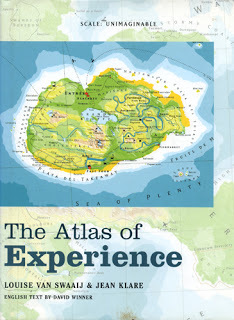
Maps demonstrate the alchemy of words and pictures, that magic picture book double act. Words & Pictures and your imagination are doing the work of together creating a whole new thing. And because your imagination helped make it, it’s unique. So the map is words and pictures glued all together with a tremendous projection of imagination.
Falling into a Map, endless Maps
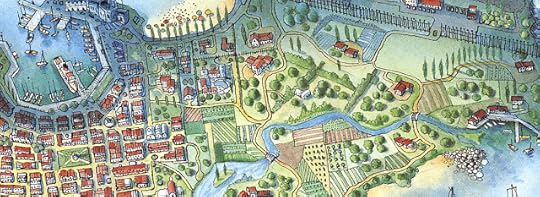
My dream is to be able to actually fall into a map and find myself in another world that I can explore. Or to find a map that I can zoom into or out of forever…from the microscopic atomic scale to the intergalactic.
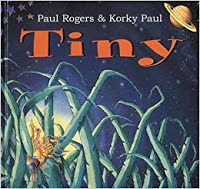
In Tiny by Korky Paul and Paul Rogers, Tiny is a flea on the back of a dog called Cleopatra living at No 72 Hilltop Road.
 Korky Paul’s marvellously detailed pictures pan out from hairs to streets to islands to planets.
Korky Paul’s marvellously detailed pictures pan out from hairs to streets to islands to planets. 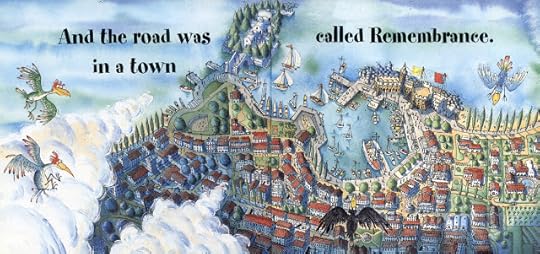 But every time I can still spot the dog, find the house still recognisable at a smaller scale.
But every time I can still spot the dog, find the house still recognisable at a smaller scale.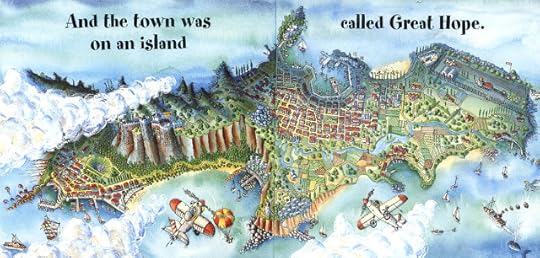 I know if I zoom back in I’ll be able to find EVERYTHING there, every bird, fish, person, dog, insect, molecule. (I love that giant octopus.)
I know if I zoom back in I’ll be able to find EVERYTHING there, every bird, fish, person, dog, insect, molecule. (I love that giant octopus.) To end with I’m going to tell you about one of the very first picture book maps I ever made.
 It was for a student project, adapting Gulliver’s Travels.
It was for a student project, adapting Gulliver’s Travels. 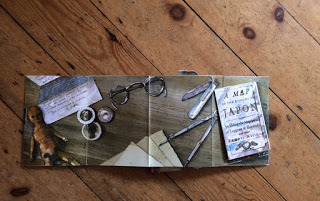 The first page opens out to show Gulliver’s desk and his map.
The first page opens out to show Gulliver’s desk and his map. 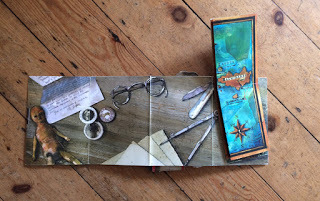 In the map you can make out Gulliver abandoned in a rowing boat, and the flying Island of Laputa about to come over and pick him up.
In the map you can make out Gulliver abandoned in a rowing boat, and the flying Island of Laputa about to come over and pick him up. 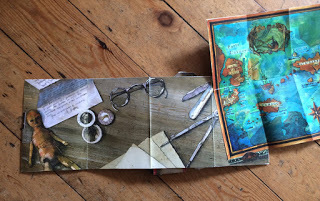 What I really really wanted was for you to be able to zoom in enough to for you to be able to see the waves rippling the water, to smell a bit of spray and hear some seabirds.
What I really really wanted was for you to be able to zoom in enough to for you to be able to see the waves rippling the water, to smell a bit of spray and hear some seabirds.
 I did (sort of, badly) manage to do this when I animated my book and falling into the map became the beginning of Gulliver’s adventures on the crazy island of Laputa.
I did (sort of, badly) manage to do this when I animated my book and falling into the map became the beginning of Gulliver’s adventures on the crazy island of Laputa.
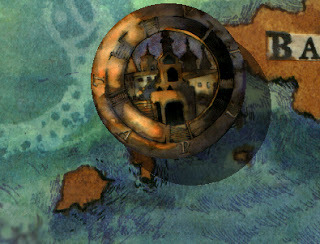 Here's the flying island of Laputa
Here's the flying island of LaputaA map is a place to roam about in the imagination. A map is a record of the discovered and the undiscovered. A map is a plan for plundering, or a diagram of how to carve up the world. A map is a journey, a story, a cast of characters, a portal.
I’ve always been obsessed with the small world. Small worlds are where we are animators as children: the doll’s house, the micro city you made among tree roots, the box of plastic dinosaurs and farm animals ready to journey down the garden. A map is a model world, and in picture books maps can come alive, using the power of words and pictures and your imagination and mine, in yet another feat of picture book magic.
PS: Interested in maps and in Oxford? There's an wonderful exhibition - Talking Maps - at the Bodleian Library you might like to visit. Details here.
Mini's latest book is The Last Wolf.Sketching Weakly is Mini's sketch-blog and you can find it here.
Published on August 25, 2019 21:30
August 19, 2019
You say 'tomato', I say 'tomato'- the process of adapting and translating a UK picture book text for the US market.
I recently tweeted that mine and Paula Metcalf's picture book 'Have You Seen My Blankie?' (published by Nosy Crow) is coming out in the US and Canada. I commented how interesting I'd found the process of working with US editors to adapt the text for their market. A few people replied to my tweet that they'd be interested in hearing a bit about that process.... and so... a new blog post is born!
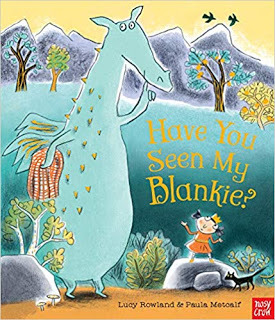
I am lucky enough to have had my stories translated into over 20 different languages now, which feels very special and a real honour! The photo below shows a small selection of those books.
 I've found, for the most part, that I've not been particularly involved in (or asked about) the translation process. (Not that I would have very much to add when it came to Lithuanian or Finnish versions of my stories!)
I've found, for the most part, that I've not been particularly involved in (or asked about) the translation process. (Not that I would have very much to add when it came to Lithuanian or Finnish versions of my stories!)
But when it comes to the American English editions, I always find it interesting.
Sometimes I get asked to change only a line or two.
Sometimes the US English edition is exactly the same as the British English version.
Sometimes, when the book is sent to me, I notice a few small changes have been made, which I wasn't necessarily informed of, and which I always find interesting to spot!
In the British English version of Sammy Claws the Christmas cat, Santa is left treats of mince pies.
'That night, Santa worked just as hard as could be, but still found some time for a mince pie...or three!)
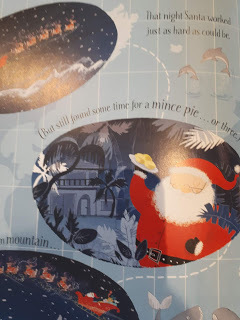
However, when I read the American English version, both the text and the illustration had been changed to 'cookies'.
'That night Santa worked just as hard as could be but still found some time for a cookie or three.'
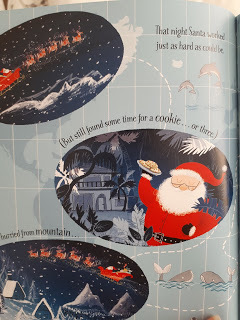 I guess Santa doesn't eat mince pies in America or Canada. I never knew!!
I guess Santa doesn't eat mince pies in America or Canada. I never knew!!
However, sometimes, the translation process between British and American English versions requires a bit more back and forth, with the US editors either suggesting changes themselves for the author to OK, or asking for the author to come up with some new text where the British English lines just aren't quite going to work. This is the way it was with 'Have you Seen My Blankie?'
Below, I've lain out the text verse by verse with both the British and American English versions so that you can see the kind of changes that we made to this story. Happy reading!
UK text Have You Seen My Blankie?
US text Have You Seen My Blankie?
Once, inside a palace, lived a young princess called Alice,
and Alice had a blankie that she always took to bed.
This blankie was so cuddly! So soft and warm and snuggly!
But one day it went missing! 'Where's my blankie?' Alice said.
Once, inside a palace, lived a young princess named Alice,
and Alice had a blankie that she always took to bed.
This blankie was so cuddly! So soft and warm and snuggly!
But one day it went missing! 'Where's my blankie?' Alice said.
Alice ran across the floor and hurried to the palace door.
She called to Jack, her brother, who was playing in his den.
He said 'Oh, yes, I'm certain that I used it as a curtain,
but that was quite some time ago- a giant took it then.'
Alice ran across the floor and hurried to the palace door.
She called out to her brother, 'Do you have my blankie, Jack?'
He said 'No but I'm certain that I used it as a curtain,
But then a giant took it and he wouldn't give it back.'
Alice tracked the giant down. She rang his doorbell with a frown.
Giant Jim said 'Come on in! I've made some lovely pies.'
He said 'I had your blankie and I used it as a hankie,
but then a witch discovered it and flew off through the skies!'
Alice tracked the giant down. She rang his doorbell with a frown.
Giant Jim said 'Come on in! I've made some lovely pies.'
' Yes, I had your blankie and I used it as a hankie,
but then a witch discovered it and flew off through the skies!'
Alice started out once more. She knocked upon the witch's door.
The witch said 'Oh, your blankie? Yes, it made a lovely cloak.
But if I'm not mistaken, dear, my lovely cloak was taken!'
She pointed to the trees, where Princess Alice spied some smoke.
Alice headed out once more and knocked upon the witch's door.
The witch said 'Oh, your blankie? Yes, it made a lovely cloak.
But if I'm not mistaken, it seems that it was taken!'
She pointed to the trees, where Princess Alice spied some smoke.
Alice went exploring and she heard some noisy snoring!
She walked into the forest and was trying to be brave.
But then she saw her blankie and a dragon looking cranky.
'Who disturbs my slumbers?' roared the dragon from his cave.
So Alice went exploring. Soon she heard some noisy snoring!
She walked into the forest and was trying to be brave.
But then she saw her blankie with a dragon who looked cranky
'Who disturbs my slumbers?' roared the dragon from his cave.
Alice felt a little scared. 'That's my blankie!' she declared.
But suddenly she realised that this dragon wasn't tough!
The dragon sadly bowed his head. 'It's just so very soft' he said.
'Your blankie helps me sleep because my bed is cold and rough.'
Alice felt a little scared. 'That's my blankie!' she declared.
And suddenly she realized that this dragon wasn't tough!
The dragon sadly bowed his head. 'It's just so very soft' he said.
'Your blankie helps me sleep because my bed is cold and rough.'
Princess Alice looked quite cross. 'It's time to show him just who's boss!'
But when she reached for Blankie...Oh! The dragon looked so blue.
And Alice thought about it. 'Well, he'll never sleep without it.
I wonder' said the princess 'If there's something I can do?'
Princess Alice felt quite mad. What a tiring day she'd had!
She tried to take her blankie ...but the dragon looked so blue.
And Alice thought about it. 'Well, he'll never sleep without it.
I wonder' said the princess 'If there's something I can do?'
Just then she had a good idea. 'Yes, of course! The answer's clear!
We'll find you something snuggly, soft and warm' the princess said.
The dragon whispered 'Oh, yes please!' He gave the blankie one last squeeze
then handed it to Alice as he wriggled from his bed.
Just then she had a good idea. 'Yes, of course! The answer's clear!
We'll find you something snuggly, soft and warm' the princess said.
The dragon whispered 'Oh, yes please!' He gave the blankie one last squeeze
then handed it to Alice as he got up from his bed.
Alice and her new-found friend, left the woods and... round the bend..
they came upon the witch's house. They hoped that she could help.
The witch said 'Try my snuggly cat? She's sleeping here inside my hat.'
'But cats are far too scratchy!' said the dragon with a yelp.
Alice and her new-found friend, left the woods and... round the bend..
they came upon the witch's house. They hoped that she could help.
The witch said 'Try my snuggly cat? She's sleeping here inside my hat.'
'But cats are far too scratchy!' said the dragon with a yelp.
The dragon was now trying to stop himself from crying.
So Alice spoke to Giant Jim who gave it quite some thought.
My feather cushion's soft' he said. 'Perhaps you could try that instead?'
'But feather make me sneezy! said the dragon with a snort.
The dragon was now trying to stop himself from crying.
So Alice spoke to Giant Jim who offered them some pie .
My feather pillow' s soft' he said. 'Perhaps you could try that instead?'
'But feather make me sneezy! said the dragon with a sigh.
The dragon's tears were flowing so the princess kept on going.
They flew to find her brother. 'Do you have any ideas?'
'Socks are warm!' young Jack replied. 'I've got an extra pair inside?'
'But socks are far too stinky!' said the dragon through his tears.
The dragon's tears were flowing so the princess kept on going.
They flew to ask her brother Jack if he could help them out.
'Socks are warm!' Prince Jack replied. 'I've got an extra pair inside?'
'But socks are far too stinky!' said the dragon with a shout.
Princess Alice felt so bad. The dragon looked so very sad.
He sobbed 'I need a blankie or I'll never sleep tonight!'
Alice stroked the dragon's head and then she very gently said
'Don't give up! I promise we'll find something that's just right!'
Princess Alice felt so bad. The dragon looked so very sad.
He sobbed 'I need a blankie or I'll never sleep tonight!'
Alice stroked the dragon's head and then she very gently said
'Don't give up! I promise we'll find something that's just right!'
The dragon followed Alice and they went inside the palace.
'We need something that's soft' she told him 'warm and snuggly too'
They tried the kitchen and the porch. They checked the attic (with a torch)
Then, in her bedroom, Alice cried 'I've just the thing for you!'
The dragon followed Alice and they went inside the palace.
'We need something that's soft' she told him 'warm and snuggly too'
The attic had a lot of stuff but everything felt hard or rough.
Then, in her bedroom, Alice cried 'I've just the thing for you!'
With lots of noisy puffing, some heaving and some huffing.
The princess showed the dragon...'Look!...my fluffy teddy bear!'
The dragon, beaming brightly, held on to Teddy tightly
and Alice felt so pleased that she'd found just the thing to share.'
With lots of noisy puffing, some heaving and some huffing.
The princess showed the dragon...'Look!...my fluffy teddy bear!'
The dragon, beaming brightly, held on to Teddy tightly
and Alice felt so pleased that she'd found just the thing to share.'
Inside a royal palace, lives a young princess called Alice
but now she has a dragon who will often come to stay.
So anyone who' scheming, beware the dragon dreaming.
He's guarding Ted and Blankie...so you'd better keep away!
Inside a royal palace, lives a young princess named Alice
And now there is a dragon who will often come to stay.
So anyone who' scheming, beware the dragon dreaming.
He's guarding bear and blankie...so you'd better keep away!
Do you have any examples of other changes that you have noticed when comparing British English vs American English texts?

I am lucky enough to have had my stories translated into over 20 different languages now, which feels very special and a real honour! The photo below shows a small selection of those books.
 I've found, for the most part, that I've not been particularly involved in (or asked about) the translation process. (Not that I would have very much to add when it came to Lithuanian or Finnish versions of my stories!)
I've found, for the most part, that I've not been particularly involved in (or asked about) the translation process. (Not that I would have very much to add when it came to Lithuanian or Finnish versions of my stories!)But when it comes to the American English editions, I always find it interesting.
Sometimes I get asked to change only a line or two.
Sometimes the US English edition is exactly the same as the British English version.
Sometimes, when the book is sent to me, I notice a few small changes have been made, which I wasn't necessarily informed of, and which I always find interesting to spot!
In the British English version of Sammy Claws the Christmas cat, Santa is left treats of mince pies.
'That night, Santa worked just as hard as could be, but still found some time for a mince pie...or three!)

However, when I read the American English version, both the text and the illustration had been changed to 'cookies'.
'That night Santa worked just as hard as could be but still found some time for a cookie or three.'
 I guess Santa doesn't eat mince pies in America or Canada. I never knew!!
I guess Santa doesn't eat mince pies in America or Canada. I never knew!!However, sometimes, the translation process between British and American English versions requires a bit more back and forth, with the US editors either suggesting changes themselves for the author to OK, or asking for the author to come up with some new text where the British English lines just aren't quite going to work. This is the way it was with 'Have you Seen My Blankie?'
Below, I've lain out the text verse by verse with both the British and American English versions so that you can see the kind of changes that we made to this story. Happy reading!
UK text Have You Seen My Blankie?
US text Have You Seen My Blankie?
Once, inside a palace, lived a young princess called Alice,
and Alice had a blankie that she always took to bed.
This blankie was so cuddly! So soft and warm and snuggly!
But one day it went missing! 'Where's my blankie?' Alice said.
Once, inside a palace, lived a young princess named Alice,
and Alice had a blankie that she always took to bed.
This blankie was so cuddly! So soft and warm and snuggly!
But one day it went missing! 'Where's my blankie?' Alice said.
Alice ran across the floor and hurried to the palace door.
She called to Jack, her brother, who was playing in his den.
He said 'Oh, yes, I'm certain that I used it as a curtain,
but that was quite some time ago- a giant took it then.'
Alice ran across the floor and hurried to the palace door.
She called out to her brother, 'Do you have my blankie, Jack?'
He said 'No but I'm certain that I used it as a curtain,
But then a giant took it and he wouldn't give it back.'
Alice tracked the giant down. She rang his doorbell with a frown.
Giant Jim said 'Come on in! I've made some lovely pies.'
He said 'I had your blankie and I used it as a hankie,
but then a witch discovered it and flew off through the skies!'
Alice tracked the giant down. She rang his doorbell with a frown.
Giant Jim said 'Come on in! I've made some lovely pies.'
' Yes, I had your blankie and I used it as a hankie,
but then a witch discovered it and flew off through the skies!'
Alice started out once more. She knocked upon the witch's door.
The witch said 'Oh, your blankie? Yes, it made a lovely cloak.
But if I'm not mistaken, dear, my lovely cloak was taken!'
She pointed to the trees, where Princess Alice spied some smoke.
Alice headed out once more and knocked upon the witch's door.
The witch said 'Oh, your blankie? Yes, it made a lovely cloak.
But if I'm not mistaken, it seems that it was taken!'
She pointed to the trees, where Princess Alice spied some smoke.
Alice went exploring and she heard some noisy snoring!
She walked into the forest and was trying to be brave.
But then she saw her blankie and a dragon looking cranky.
'Who disturbs my slumbers?' roared the dragon from his cave.
So Alice went exploring. Soon she heard some noisy snoring!
She walked into the forest and was trying to be brave.
But then she saw her blankie with a dragon who looked cranky
'Who disturbs my slumbers?' roared the dragon from his cave.
Alice felt a little scared. 'That's my blankie!' she declared.
But suddenly she realised that this dragon wasn't tough!
The dragon sadly bowed his head. 'It's just so very soft' he said.
'Your blankie helps me sleep because my bed is cold and rough.'
Alice felt a little scared. 'That's my blankie!' she declared.
And suddenly she realized that this dragon wasn't tough!
The dragon sadly bowed his head. 'It's just so very soft' he said.
'Your blankie helps me sleep because my bed is cold and rough.'
Princess Alice looked quite cross. 'It's time to show him just who's boss!'
But when she reached for Blankie...Oh! The dragon looked so blue.
And Alice thought about it. 'Well, he'll never sleep without it.
I wonder' said the princess 'If there's something I can do?'
Princess Alice felt quite mad. What a tiring day she'd had!
She tried to take her blankie ...but the dragon looked so blue.
And Alice thought about it. 'Well, he'll never sleep without it.
I wonder' said the princess 'If there's something I can do?'
Just then she had a good idea. 'Yes, of course! The answer's clear!
We'll find you something snuggly, soft and warm' the princess said.
The dragon whispered 'Oh, yes please!' He gave the blankie one last squeeze
then handed it to Alice as he wriggled from his bed.
Just then she had a good idea. 'Yes, of course! The answer's clear!
We'll find you something snuggly, soft and warm' the princess said.
The dragon whispered 'Oh, yes please!' He gave the blankie one last squeeze
then handed it to Alice as he got up from his bed.
Alice and her new-found friend, left the woods and... round the bend..
they came upon the witch's house. They hoped that she could help.
The witch said 'Try my snuggly cat? She's sleeping here inside my hat.'
'But cats are far too scratchy!' said the dragon with a yelp.
Alice and her new-found friend, left the woods and... round the bend..
they came upon the witch's house. They hoped that she could help.
The witch said 'Try my snuggly cat? She's sleeping here inside my hat.'
'But cats are far too scratchy!' said the dragon with a yelp.
The dragon was now trying to stop himself from crying.
So Alice spoke to Giant Jim who gave it quite some thought.
My feather cushion's soft' he said. 'Perhaps you could try that instead?'
'But feather make me sneezy! said the dragon with a snort.
The dragon was now trying to stop himself from crying.
So Alice spoke to Giant Jim who offered them some pie .
My feather pillow' s soft' he said. 'Perhaps you could try that instead?'
'But feather make me sneezy! said the dragon with a sigh.
The dragon's tears were flowing so the princess kept on going.
They flew to find her brother. 'Do you have any ideas?'
'Socks are warm!' young Jack replied. 'I've got an extra pair inside?'
'But socks are far too stinky!' said the dragon through his tears.
The dragon's tears were flowing so the princess kept on going.
They flew to ask her brother Jack if he could help them out.
'Socks are warm!' Prince Jack replied. 'I've got an extra pair inside?'
'But socks are far too stinky!' said the dragon with a shout.
Princess Alice felt so bad. The dragon looked so very sad.
He sobbed 'I need a blankie or I'll never sleep tonight!'
Alice stroked the dragon's head and then she very gently said
'Don't give up! I promise we'll find something that's just right!'
Princess Alice felt so bad. The dragon looked so very sad.
He sobbed 'I need a blankie or I'll never sleep tonight!'
Alice stroked the dragon's head and then she very gently said
'Don't give up! I promise we'll find something that's just right!'
The dragon followed Alice and they went inside the palace.
'We need something that's soft' she told him 'warm and snuggly too'
They tried the kitchen and the porch. They checked the attic (with a torch)
Then, in her bedroom, Alice cried 'I've just the thing for you!'
The dragon followed Alice and they went inside the palace.
'We need something that's soft' she told him 'warm and snuggly too'
The attic had a lot of stuff but everything felt hard or rough.
Then, in her bedroom, Alice cried 'I've just the thing for you!'
With lots of noisy puffing, some heaving and some huffing.
The princess showed the dragon...'Look!...my fluffy teddy bear!'
The dragon, beaming brightly, held on to Teddy tightly
and Alice felt so pleased that she'd found just the thing to share.'
With lots of noisy puffing, some heaving and some huffing.
The princess showed the dragon...'Look!...my fluffy teddy bear!'
The dragon, beaming brightly, held on to Teddy tightly
and Alice felt so pleased that she'd found just the thing to share.'
Inside a royal palace, lives a young princess called Alice
but now she has a dragon who will often come to stay.
So anyone who' scheming, beware the dragon dreaming.
He's guarding Ted and Blankie...so you'd better keep away!
Inside a royal palace, lives a young princess named Alice
And now there is a dragon who will often come to stay.
So anyone who' scheming, beware the dragon dreaming.
He's guarding bear and blankie...so you'd better keep away!
Do you have any examples of other changes that you have noticed when comparing British English vs American English texts?
Published on August 19, 2019 12:57
August 11, 2019
Zoom Zoom Zoom! by Chitra Soundar
5,4,3,2,1ZOOM!
This year’s Summer Reading Challenge is themed on Space Chase. Librarians across the country are counting down the reading of children and awarding them medals for exploring the planet of reading.
Space achievement has always been seen as an achievement of the west. However historical records indicate that Indians and Arabs, have longed practiced astronomy and many of our 3000-old epics and scriptures refer to nine planets and moons (which perhaps today has been changed to eight and I feel for Pluto).
As we celebrate the anniversary of the moon landing, India my birth country has launched a shuttle Chandrayaan 2 to the dark side of the moon (which is a first) and that has come within two years of India launching a rover to Mars (the same time as the US, in a fraction of the cost). What was even more wonderful was that the picture that captured India’s imagination – women scientists in their saris celebrating the launch of the rover, women who have forged paths not just on Earth but into space.

Sriharikota is a small town, a few hours from where I lived captured my imagination when I was young. It was the rocket launch site and the home of ISRO – the Indian Space Research Organisation. Then as a young professional, who mentored students on their internships, I had the honour of visiting the organisation and walked into these halls that echoed the dreams of many.
A P J Abdul Kalam, India’s 11th President was an aerospace scientist who had come from humble beginnings from the same state I belonged. He spent all his life spreading the joy of science and experimentation, and motivating youth to study and aim for the stars. (Read about APJ Abdul Kalam in this new book by Rashmi Sirdeshpande).
This also reminded me of Kalpana Chawla, a hero back in India, a US citizen, who became the first astronaut of Indian ancestry to go into space. Sadly she was on the space shuttle Columbia on her second space journey, which disintegrated on its re-entry into earth’s atmosphere.
But between her first and second missions and even after her death, she continues to inspire many young women and men to become astronauts, especially those who don’t seem to be represented in those professions.
And so when this year my picture book Farmer Falgu Goes KiteFlying was chosen for the Summer Reading Challenge in the year Space Chase was the theme, I got super excited just as Eila is in this book flying kites. Flying a kite is the first step towards aspiring to become an astronaut I think.
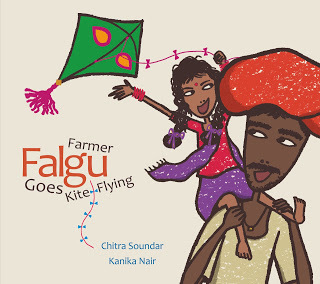
Then I asked the question - Are there are enough books about space heroes who are persons of colour and are they written and illustrated by BAME writers about space?
The good news is yes there are. The bad news is as always – not that many, especially not that many written by writers of colour.
Here are the ones I found – please buy them, recommend them and share them with all children – so that it is a dream that can be shared by all. And let's hope there are more books than the fingers on one hand that are written by authors of colour about space and space heroes of colour.
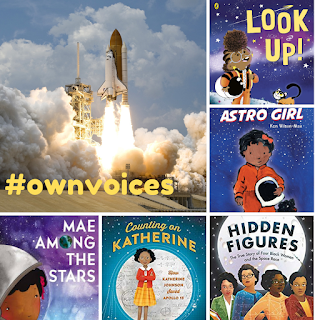 #OwnVoices picture books and non-fiction across UK and US
#OwnVoices picture books and non-fiction across UK and US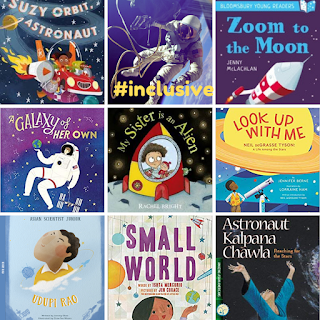 #Inclusive picture books, biographies and more published across the world
#Inclusive picture books, biographies and more published across the world
Published on August 11, 2019 23:00



